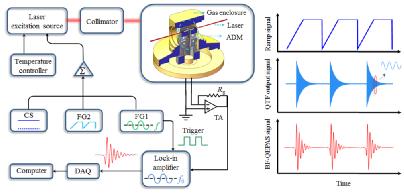Article confirms breakthrough for BF-QEPAS detection
Updated: 2017-06-06
 |
|
A schematic illustration of the experimental set-up demonstrates the performance of the BF-QEPAS spectrophone. [Photo/nature.com] |
Professor Dong Lei from the Institute of Laser Spectroscopy of Shanxi University and his doctoral candidate, Wu Hongpeng, worked with Professor Frank K. Tittle from Rice University in the United States to co-publish an important online article in Nature Communications on May 31, 2017.
The article reported that beat frequency quartz-enhanced photoacoustic spectroscopy (BF-QEPAS) can be used for ultra-sensitive calibration-free trace-gas detection and fast spectral scan applications. BF-QEPAS avoids a calibration process and permits continuous monitoring of a targeted trace gas. The BF-QEPAS method is capable of measuring lower trace-gas concentration levels with shorter average times.
Dong Lei was born in Xinxiang, Henan province, in 1979. He received a bachelor's degree in electronics from Shanxi University in 2002, obtained a PhD in optical engineering from the State Key Laboratory of Quantum Optics and Quantum Optics Devices in 2007, then taught there after graduating in 2007. He became a professor in 2014.
Dong was funded by the National Natural Science Foundation for Outstanding Youth Fund Project in 2016. He mainly focused on research into laser spectrum sensing technology, and has made a number of important achievements in the field of photoacoustic spectrum, especially quartz-enhanced photoacoustic spectroscopy (QEPAS) for trace-gas detection.
INTERNATIONAL EDUCATION EXCHANGE
-
 Confucius Institutes
Confucius Institutes The Confucius Institutes are set up worldwide by the Chinese Language Council International to promote Chinese language and culture.
-
 Enrollment of Foreign Students in Shanxi University
Enrollment of Foreign Students in Shanxi University Join us and explore our wide range of study programs and enjoy a first class educational experience that makes you a part of a lively global community.

